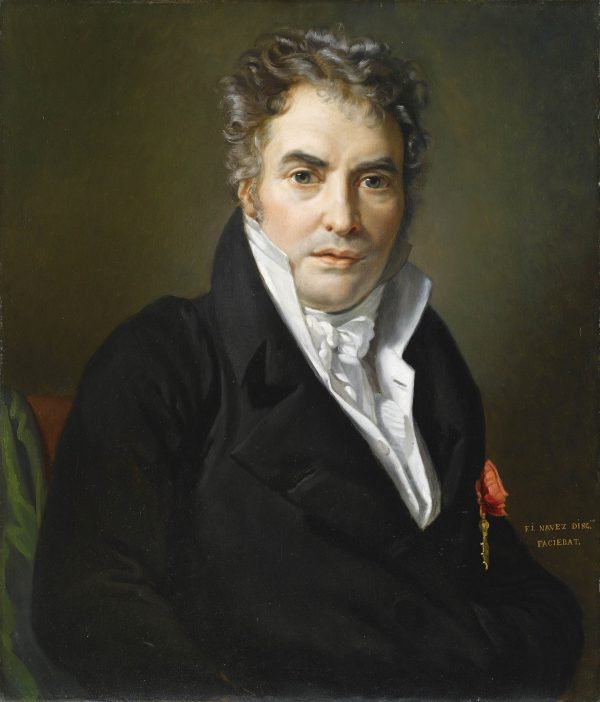Portrait of Jacques Louis David, 1817
Oil on panel, H. 0.67 m; W. 0.56 m
Signed lower right: F.J. NAVEZ DISC.us / FACIEBAT.
and inscribed by the artist on the reverse: I.bus LUD.cus DAVID AETATIS SUAE 67 / BRUX.lis ANNO 1817. / FINI LE 27 SEPTEMBRE avant veille / DE MON DEPART POUR ROME.
Provenance: Private collection, France.
Having trained first at the Royal Academy of Brussels and in Pierre-Joseph-Célestin François’ workshop, Navez obtained a scholarship to study in Paris. Between 1813 and 1816 he was a pupil of Jacques-Louis David, whom he then accompanied in his exile to Brussels. Navez had obtained a scholarship for Rome, but preferred to work under David in Brussels for another two years, before leaving for Italy where he would spend four years.
On his return from Italy, Navez, although he was already famous as a portrait painter and especially appreciated by the Belgian upper middle class, tried to establish himself as a history painter, in particular with religious paintings. As director of the Belgian Royal Academy of Arts from 1835 to 1862, he trained numerous artists, among whom the Orientalist Jean-François Portaels (his later son-in-law) and Alfred Stevens.
Our portrait dates from the period Navez spent in Brussels before his departure for Rome. As he didn’t benefit from any scholarship, he had to earn his living. Hence the execution of a large number of portraits, all of them clearly showing David’s influence.
In September of 1817, during the last weeks before his departure, Navez painted several portraits of David. He probably thought that after a long absence he would not see his revered master again. In a first version, kept today at the Musée des Beaux-Arts in Valenciennes, David seems older than in the other versions, and the asymmetry of the face is sharply marked. This picture was carefully inscribed and documented with this information on the reverse by the artist himself: “67-year-old Louis David, 1st portrait painted from life on September 7th, 1817; this one is the most resembling. Mr David made me start all over again the one [word missing] that Potrel engraved because I had not hidden the flaw on his cheek. The accessories were painted after the portrait that is at Hemptinne, which is also a portrait I made of Mr David from life, F.J. Navez.”
In 1931, Leo Van Puyvelde in his biography on Navez discussed these three portraits as follows: “He then painted three portraits of his master David: one was offered to his master, another one was given to Auguste de Hemptinne, the third one would later be in the Portaels collection. The best of these portraits is at present in the baron Houtart’s collection in Monceau-sur-Sambre, the second is in the Musée Royal d’Art moderne in Brussels, the third is part of the Meurice-Van Gilse collection in Brussels.” (Léo van Puyvelde, François-Joseph Navez, Bruxelles, 1931, p. 7.)
This last picture was the very first version, refused by David, and was part of the Portaels collection (the artist’s son-in-law), and was later acquired by the Musée des Beaux-Arts in Valenciennes. The picture offered to David, engraved by Potrelle, was bequeathed to the museum of Brussels by David’s grandson, Jules David-Chassagnol.
Could the present painting be the portrait given to Auguste de Hemptinne? This picture was in baron Houtart’s collection in Monceau-sur-Sambre in 1931, and André Hardy did not know its location in 1980 (André Hardy, « Un portrait de David par Navez », La Revue du Louvre, 1980. n° 5-6, p. 315, note 5). But if one is to believe the inscription on the back of the Valenciennes painting, the accessories of the Brussels version were painted after the portrait given to Auguste de Hemptinne, which therefore makes an older version. According to the inscription on the back of the present picture, it was painted two days before Navez’s departure to Italy, and is most likely the last one of the series.
The Portrait of Jacques Louis David had an immense success. According to the Grande Encyclopédie, “his [Navez’s] best works are Louis David’s portrait and his own portrait”. In 1836, when he visited Navez’s workshop, the count of Schönborn saw the Valenciennes version. He immediately commissioned Navez for a copy of the portrait, showing the hands of the model. This picture is currently on loan in the Montreal Museum of Fine arts.
The present painting shows David seated, turned three-quarters to the right, looking firmly at the spectator. His black jacket, decorated with the cross of the Legion of Honour, opens on a white jabot. There is a lot of care taken on the rendering of his face, with no accessories. A green monochrome background sets off the figure.
Navez managed to confer to this portrait an impressive presence. In his strong and straightforward manner, close to the Flemish tradition of the 17th century, the artist expressed all the sympathy he had for his friend and mentor.
